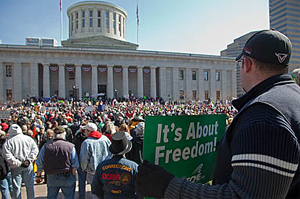Ohioans Can Overturn Anti-Labor Bill through Referendum—Again

Ohio legislators passed their bill destroying public sector bargaining rights Wednesday night.
It bases raises on management-controlled performance measures, not seniority, prevents public workers from striking, mandates much higher health costs for workers, and allows a decertification vote if 30 percent of members sign a petition. Contracts can be declared null and void if a town or school district declares “financial emergency.”
Tens of thousands of Ohioans took to their Capitol in the last two months to register their outrage. Another thousand were there yesterday, yelling “shame on you” and “repeal” at the lawmakers as they passed the bill.
The fight’s not over. Ohio activists are assembling their forces for a ballot option to turn the bill back. If opponents can gather 231,000 valid signatures by the end of June, the measure will be suspended and put before voters as a referendum in November. Democrats and unions say they will spend $20 million to defeat the bill.
The unions have used the ballot box to beat back similar attacks before. In 1997, unions overturned the legislature’s swipe at workers’ comp in a referendum. Jerry Gordon, a retired UFCW rep, fills in the details.
When the legislature passed the 1997 “reform” of Ohio’s workplace injury insurance plan, the labor movement turned from statehouse lobbying to working class voting to abort the regressive law before it could be put into effect.
What was involved? Tightening eligibility would mean denying disability benefits to people who cannot work; denying coverage to workers who contract occupational cancers and other occupational diseases, or who suffer from carpal tunnel or other repetitive-motion injuries; and cutting benefits to those with permanent partial disabilities.
With 350,000 Ohio workers injured on the job annually, it was clear just how much was at stake in the outcome of this fight. It was also clear that a lot was at stake for the employers, who stood to profit by a $200 million a year tax cut if the referendum received a “yes” vote.
As soon as Governor George Voinovich signed the bill in April, the UAW and the AFL-CIO formed the Committee to Stop Corporate Attacks on Injured Workers and launched a campaign for a referendum. Joining them were the building and construction trades, Teamsters, and independent unions.
On July 21, the secretary of state received 415,000 signatures and the law was suspended pending the outcome of the November 4 vote. An all-out mobilization of the rank and file brought the signatures in fast.
The unions’ drive for a “no” vote in November was intended to reach every possible voter with the facts of how the new law would hurt injured workers—union and non-union alike.

SUPPORT LABOR NOTES
BECOME A MONTHLY DONOR
Give $10 a month or more and get our "Fight the Boss, Build the Union" T-shirt.
Ohio voters weren’t accustomed to ballot measures: This was the first time since 1939 that Ohioans were asked to vote down a piece of anti-worker corporate takeaway legislation that the Assembly had passed.
The drive gathered allies. Besides workers’ organizations, organizations calling for a “no” vote included the NAACP, Ohio Council of Senior Citizens, and the Consumers League of Ohio. People outside organized labor had to be convinced that gutting the workers’ compensation system was against their interests, in addition to being morally wrong.
Labor was up against all of the big business crowd: the National Association of Manufacturers, the Chamber of Commerce, the Ohio Council of Retail Merchants.
“We fought the bill all the way through, when others said it couldn’t be done,” said Warren Davis, a UAW executive board member who co-chaired the campaign.
It became clear that the bosses and the politicians had made a serious miscalculation. They had not expected labor and its allies to mount an all-out campaign.
The united labor coalition distributed 240,000 yard signs. Leaflets by the hundreds of thousands were printed and circulated. The tactics included direct mail, town meetings, videotapes, phonebanks, postings on campuses and church bulletin boards, house-to-house visits in working class neighborhoods, community meetings, research, media work, stories from injured workers proving how unjust the proposed changes were, statements of support from the politicians, and frequent rallies and demonstrations.
The campaign went forward with a fury. Both sides raised millions of dollars, with the corporations outspending labor by probably 7-1. That’s just what the campaign could account for.
On Election Day, the vote was 1.7 million against to 1.2 million in favor: a 57 percent to 43 percent victory for labor.
Explaining the outcome of the vote, Davis said, “Ohio workers understood this was a takeaway bill launched by multinational corporations against injured workers.”
The UAW’s magazine ran with the headline: “THEY HAD THE MONEY, WE HAD THE PEOPLE.”
A related campaign: When Missouri's Republicans pushed a right to work bill in 1978, unions mobilized and put together the strongest coalition of progressive forces Missouri has ever seen—defeating right to work and dealing Republicans a lasting defeat.




